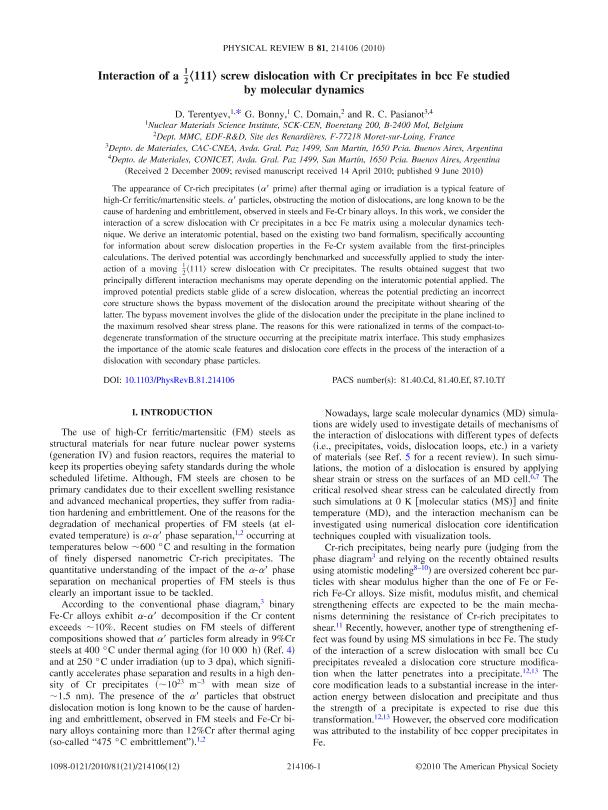Mostrar el registro sencillo del ítem
dc.contributor.author
Terentyev, D.
dc.contributor.author
Bonny, G.
dc.contributor.author
Domain, C.
dc.contributor.author
Pasianot, Roberto Cesar

dc.date.available
2023-02-28T14:55:28Z
dc.date.issued
2010-06
dc.identifier.citation
Terentyev, D.; Bonny, G.; Domain, C.; Pasianot, Roberto Cesar; Interaction of a 1/2〈111〉 screw dislocation with Cr precipitates in bcc Fe studied by molecular dynamics; American Physical Society; Physical Review B: Condensed Matter and Materials Physics; 81; 21; 6-2010; 1-12
dc.identifier.issn
0163-1829
dc.identifier.uri
http://hdl.handle.net/11336/189098
dc.description.abstract
The appearance of Cr-rich precipitates (α′ prime) after thermal aging or irradiation is a typical feature of high-Cr ferritic/martensitic steels. α′ particles, obstructing the motion of dislocations, are long known to be the cause of hardening and embrittlement, observed in steels and Fe-Cr binary alloys. In this work, we consider the interaction of a screw dislocation with Cr precipitates in a bcc Fe matrix using a molecular dynamics technique. We derive an interatomic potential, based on the existing two band formalism, specifically accounting for information about screw dislocation properties in the Fe-Cr system available from the first-principles calculations. The derived potential was accordingly benchmarked and successfully applied to study the interaction of a moving 1/2〈111〉 screw dislocation with Cr precipitates. The results obtained suggest that two principally different interaction mechanisms may operate depending on the interatomic potential applied. The improved potential predicts stable glide of a screw dislocation, whereas the potential predicting an incorrect core structure shows the bypass movement of the dislocation around the precipitate without shearing of the latter. The bypass movement involves the glide of the dislocation under the precipitate in the plane inclined to the maximum resolved shear stress plane. The reasons for this were rationalized in terms of the compact-to-degenerate transformation of the structure occurring at the precipitate matrix interface. This study emphasizes the importance of the atomic scale features and dislocation core effects in the process of the interaction of a dislocation with secondary phase particles.
dc.format
application/pdf
dc.language.iso
eng
dc.publisher
American Physical Society
dc.rights
info:eu-repo/semantics/openAccess
dc.rights.uri
https://creativecommons.org/licenses/by-nc-sa/2.5/ar/
dc.subject
DISLOCATIONS
dc.subject
CR PRECIPITATES
dc.subject
BCC FE
dc.subject
MOLECULAR DYNAMICS
dc.subject.classification
Ingeniería de los Materiales

dc.subject.classification
Ingeniería de los Materiales

dc.subject.classification
INGENIERÍAS Y TECNOLOGÍAS

dc.title
Interaction of a 1/2〈111〉 screw dislocation with Cr precipitates in bcc Fe studied by molecular dynamics
dc.type
info:eu-repo/semantics/article
dc.type
info:ar-repo/semantics/artículo
dc.type
info:eu-repo/semantics/publishedVersion
dc.date.updated
2023-02-20T14:12:40Z
dc.journal.volume
81
dc.journal.number
21
dc.journal.pagination
1-12
dc.journal.pais
Estados Unidos

dc.description.fil
Fil: Terentyev, D.. Sck-Cen; Bélgica
dc.description.fil
Fil: Bonny, G.. Sck-Cen; Bélgica
dc.description.fil
Fil: Domain, C.. Electricité de France; Francia
dc.description.fil
Fil: Pasianot, Roberto Cesar. Consejo Nacional de Investigaciones Científicas y Técnicas; Argentina. Comisión Nacional de Energía Atómica; Argentina
dc.journal.title
Physical Review B: Condensed Matter and Materials Physics

dc.relation.alternativeid
info:eu-repo/semantics/altIdentifier/url/https://journals.aps.org/prb/abstract/10.1103/PhysRevB.81.214106
dc.relation.alternativeid
info:eu-repo/semantics/altIdentifier/doi/http://dx.doi.org/10.1103/PhysRevB.81.214106
Archivos asociados
